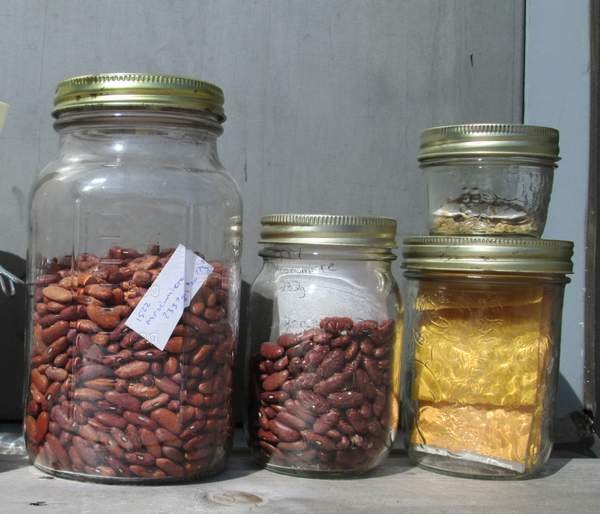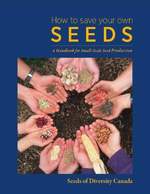Back to November 2015 Newsletter
Storing Your Saved Seeds

Bob Wildfong
Did you save some seeds this year? Our recent survey showed that two-thirds of our readers save their own seeds, at least for their own use. If your seeds were harvested from healthy plants and allowed to ripen fully, your seeds should grow well when you plant them in the spring.
But what if you want to keep them for a few years? How long will those seeds last?
The answer lies mostly in how you store them. Seeds are living things, each with a little baby plant sleeping inside and some stored food to feed that plant until it sprouts. That's the key to a seed's shelf life - it lives until its food runs out. Old seeds don't grow because they ran out of food.
In other words, to make your seeds last longer, you have to make them consume their stored food more slowly. The deeper they sleep, the slower they eat, and the longer they live. With seeds, we usually use the word "dormant" instead of sleepy, but the analogy to hibernating animals is irresistible.
What makes a seed dormant? Precisely the opposite of what makes them sprout. When you want to germinate a seed, you give it warmth, moisture, and light, so to make a seed dormant you would make it cold, dry, and dark. That forces it to slow down its metabolism, eat its food slower, and therefore last longer in the jar or envelope.
|
To germinate seeds |
Moisture triggers seeds to grow |
Warmth triggers seeds to grow |
Light is needed by some seeds to germinate |
|
To store seeds |
Dry air puts seeds to sleep |
Cold makes seeds consume food slowly |
Darkness helps keep seeds dormant |
Every seed species is a little different, but all garden seeds follow this rule of thumb. The most important point is to keep the seeds dry, and after that to keep them cool. Darkness might make a small difference, but it isn't nearly as important as dryness.
For Seeds of Diversity's seed library collection, we let our seeds air-dry completely in an open, ventilated space. Trays or shallow bowls are good for air drying, making sure that the seeds are spread out one layer deep. Once they've had a good week in dry air, they can be packaged in breathable paper bags or envelopes. Seeds can still contain moisture, even when they feel dry to the touch, so they need extra drying time before they can go in sealed containers.
In Canada, our winter air is usually quite dry, so by keeping seeds in breathable packages or bags until November or December, in typical indoor conditions (e.g. not in a humid greenhouse, or beside the shower), they should dry well enough to keep for several years.
It might be tempting to dry your seeds with a dehydrator, or an oven on "low". That works for drying food, but you have to be careful with seeds: temperatures over 40°C (about 100°F) can harm living seeds.
 There is lots more information about saving seeds in our handbook How to Save Your Own Seeds, available on our web site for $15 including shipping.
There is lots more information about saving seeds in our handbook How to Save Your Own Seeds, available on our web site for $15 including shipping.
It makes an excellent Christmas gift for your favourite gardener.
Here's a simple trick for choosing a good place to store your seeds: measure the temperature in degrees Fahrenheit, and the percentage of relative humidity. If the sum of those numbers is less than 100, you've found a pretty good place to keep seeds in the open air.
°F + %RH < 100
The lower the temperature the better, and especially the lower the humidity the better, so try these methods too:
- Put your well-dried seeds in air-tight jars, and store the jars in a fridge or cold cellar. You should never keep seeds open to the air in those places, because they're much too humid, but inside the jars the seeds will stay dry. Just remember to open and close the jars in dry air when you fetch the seeds, so you don't trap humidity inside.
- Silica gel, sold at most craft stores for drying flowers, is a material that absorbs moisture. Put an envelope of silica gel and an envelope of seeds in a sealed jar for two days. The silica will remove excess moisture from the air and also from the seeds. Remove the silica to prevent over-drying, and keep the seeds sealed in the dry jar for years.
Exactly how long your seeds will last depends on many variables. Generally, bean seeds usually last for 3-5 years if they're dry and room temperature, tomato seeds can live for up to 10 years in the same conditions, and other vegetable and flower seeds normally keep somewhere between 2-6 years.
Here are some tips to get you thinking about seed storage:
- Every 6°C (about 10°F) of lower temperature will double a seed's lifespan (at typical temperature ranges).
- Every 1% of moisture removed from a seed will double its lifespan (to a certain point; you can fatally overdry them if you use heat).
- Seeds dried in silica gel, or very dry open air, will not be damaged by freezing. Then you can really make them dormant!
- Remember to keep seeds in air-tight jars in a fridge or freezer, because the humidity is higher than you think. (There wouldn't be frost in your freezer if there weren't moisture in the air).
**
Bob Wildfong is the Executive Director of Seeds of Diversity, and has been saving seeds for over 20 years.
Not yet a member?
An annual membership to Seeds of Diversity gives you access to our seed exchange, seed grow-out programs, and our online news.

We depend on donations to do our work.

Thank you for your support!
